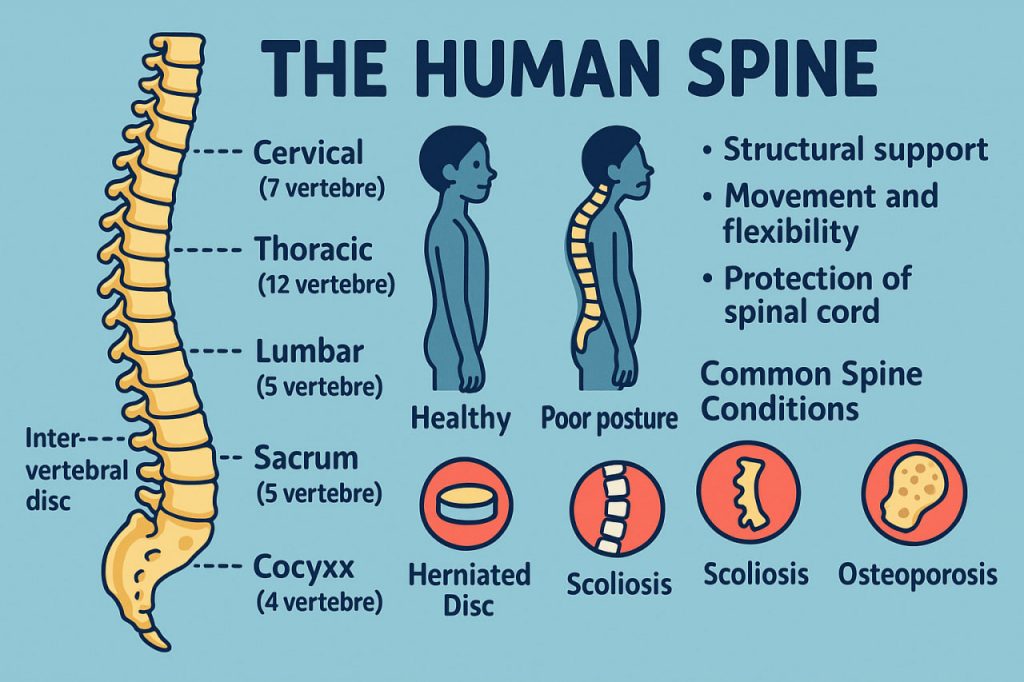The human spine, or vertebral column, is one of the most essential parts of the body’s structure. It supports the body’s weight, allows for movement and flexibility, and protects the spinal cord, the central communication pathway of the nervous system. A healthy spine is vital to posture, balance, and overall health.
Structure of the Human Spine
The spine is made up of 33 individual vertebrae, which are divided into five main regions:
- Cervical Spine (Neck) – 7 vertebrae (C1–C7)
- Supports the head and enables neck movement
- The first vertebra (atlas) holds the skull; the second (axis) allows rotation
- Thoracic Spine (Upper Back) – 12 vertebrae (T1–T12)
- Attached to the ribs
- Provides stability and protects vital organs
- Lumbar Spine (Lower Back) – 5 vertebrae (L1–L5)
- Largest and strongest vertebrae
- Bears most of the body’s weight
- Sacrum – 5 fused vertebrae (S1–S5)
- Connects the spine to the pelvis
- Coccyx (Tailbone) – 4 fused vertebrae
- A vestigial structure, providing support for sitting
Between most vertebrae are intervertebral discs, acting as cushions that absorb shock and allow flexibility.
Functions of the Spine
- Structural Support: It holds the body upright and maintains balance.
- Movement and Flexibility: Allows bending, twisting, and rotation.
- Protection: Shields the spinal cord, which transmits signals between the brain and the rest of the body.
- Attachment Point: Serves as an anchor for muscles, ribs, and pelvic bones.
Common Spine Conditions
- Herniated Disc: When the disc’s inner gel leaks out, pressing on nerves.
- Scoliosis: Abnormal curvature of the spine, usually in the thoracic region.
- Osteoporosis: Weakening of bones, increasing risk of vertebral fractures.
- Spinal Stenosis: Narrowing of the spinal canal that puts pressure on nerves.
- Sciatica: Pain caused by compression of the sciatic nerve, often from lumbar disc issues.
How to Keep Your Spine Healthy
- Maintain good posture when sitting, standing, and sleeping
- Exercise regularly to strengthen back and core muscles
- Lift with your legs, not your back
- Use ergonomic furniture and supportive mattresses
- Avoid prolonged sitting — take breaks and stretch
- Maintain a healthy weight to reduce stress on the spine
Walking is a simple way to maintain your spine’s health. The optimal number of steps per day depends on your lifestyle, but generally, it’s very beneficial to walk more than 10,000 steps a day and to engage in at least 30 minutes of continuous walking. Gradually increase the intensity each day, starting with short walks, and your spine will thank you.
Glossary
- Vertebrae: The bones that make up the spine.
- Spinal cord: A bundle of nerves running through the spine, part of the central nervous system.
- Intervertebral disc: A cartilage disc that cushions each vertebra.
- Scoliosis: A sideways curvature of the spine.
- Sciatica: Nerve pain that radiates along the sciatic nerve, usually in the legs.


